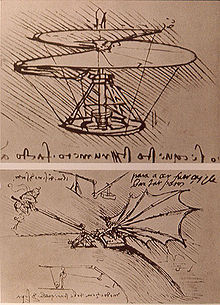Aeronautics is the science or art involved with the study, design, and manufacturing of air flight–capable machines, and the techniques of operating aircraft and rockets within the atmosphere. The British Royal Aeronautical Society identifies the aspects of "aeronautical Art, Science and Engineering" and "The profession of Aeronautics (which expression includes Astronautics)."
While the term originally referred solely to operating the aircraft, it has since been expanded to include technology, business, and other aspects related to aircraft. The term "aviation" is sometimes used interchangeably with aeronautics, although "aeronautics" includes lighter-than-air craft such as airships, and includes ballistic vehicles while "aviation" technically does not.
A significant part of aeronautical science is a branch of dynamics called aerodynamics, which deals with the motion of air and the way that it interacts with objects in motion, such as an aircraft.
History
Early ideas
Attempts to fly without any real aeronautical understanding have been made from the earliest times, typically by constructing wings and jumping from a tower with crippling or lethal results.
Wiser investigators sought to gain some rational understanding through the study of bird flight. Medieval Islamic Golden Age scientists such as Abbas ibn Firnas also made such studies. The founders of modern aeronautics, Leonardo da Vinci in the Renaissance and Cayley in 1799, both began their investigations with studies of bird flight.
Man-carrying kites are believed to have been used extensively in ancient China. In 1282 the Italian explorer Marco Polo described the Chinese techniques then current. The Chinese also constructed small hot air balloons, or lanterns, and rotary-wing toys.
An early European to provide any scientific discussion of flight was Roger Bacon, who described principles of operation for the lighter-than-air balloon and the flapping-wing ornithopter, which he envisaged would be constructed in the future. The lifting medium for his balloon would be an "aether" whose composition he did not know.
In the late fifteenth century, Leonardo da Vinci followed up his study of birds with designs for some of the earliest flying machines, including the flapping-wing ornithopter and the rotating-wing helicopter. Although his designs were rational, they were not based on particularly good science. Many of his designs, such as a four-person screw-type helicopter, have severe flaws. He did at least understand that "An object offers as much resistance to the air as the air does to the object." (Newton would not publish the Third law of motion until 1687.) His analysis led to the realisation that manpower alone was not sufficient for sustained flight, and his later designs included a mechanical power source such as a spring. Da Vinci's work was lost after his death and did not reappear until it had been overtaken by the work of George Cayley.




0 Comments